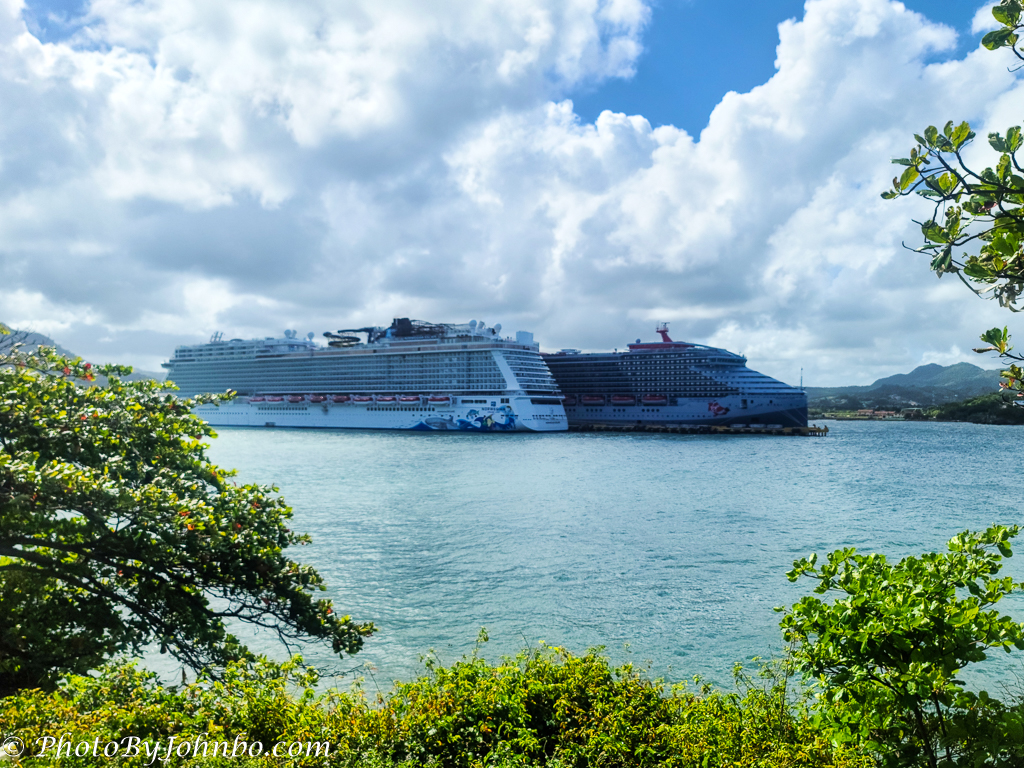
Puerto Plata, Dominican Republic.
On the north coast of the Dominican Republic, Puerto Plata, also known as San Felipe de Puerto Plata, was our first destination on the Norwegian Escape in early 2023. Puerto Plata, which translates to “Silver Port,” hints at the shimmering beaches that greet visitors upon arrival.
Puerto Plata’s history dates back to the early 1500s when Spanish colonists carved out a small settlement in the region, quickly turning it into the island’s primary commercial and maritime hub during the early years of the Captaincy General of Santo Domingo. This strategic location made the city a key player in trade and exploration, shaping the island’s future in the centuries to come.
I couldn’t find much information online about the large gorilla at our port stop. Just a short distance from our ship, the Taino Bay area is the first place visitors see when departing the ship. The one quote I noted from a cruise reviewer stated, “The large gorilla sculpture at Taino Bay in Puerto Plata, Dominican Republic, is quite the sight! Officially named “King Kong” but often referred to as “Gorilla Island,” it’s a 20-foot tall, brightly colored fiberglass sculpture that has become a popular landmark and photo op for visitors.” We continued our walk through the port shopping area and found our tour group meeting point. We then boarded a bus to tour the city.
On our tour, we visited the Fortaleza San Felipe, a 16th-century Spanish fortress. According to Wikipedia, construction of the fort began in 1564 under the reign of King Philip II of Spain and was completed in 1577. The thick walls, cannons, and strategically placed towers served as a vital defense point protecting the city and its harbor from pirates and privateers. In the 19th century, it became a prison and is now a museum and major tourist attraction. I captured the opening photo of the Norwegian Escape from the shoreline at the fort. Its strategic location was instrumental in protecting the harbor at Puerto Plata.
The city square or Parque Central dates back to the early 16th century when Spanish colonists founded Puerto Plata. Initially known as Plaza Mayor, it served as the city’s main gathering place for public events, celebrations, and trade. In the 19th century, it was renamed Plaza Independencia to commemorate the Dominican Republic’s independence from Spain in 1844. The ornate gazebo in the center of the square is a popular landmark and often features local musicians playing traditional Dominican music. Several statues pay homage to historical figures like Gregorio Luperón, José María Pérez, and Gregorio Rivas, all of whom played significant roles in Dominican history.
The building that we might call City Hall in the United States is located on the Plaza Independencia. The structure is a beautiful example of 19th-century architecture and houses various city administrative departments.
Our next stop included a visit to an amber museum. It was interesting to learn about amber and its history. Amber is a fossilized tree resin millions of years old. Dominican amber, prized for its beauty, and clarity, often contains perfectly preserved insects and other inclusions and is considered some of the finest in the world.
Our next stop included a walk about town. We started at Calle San Felipe, also known as “Umbrella Street.” It’s a pedestrian-only street adorned with colorful umbrellas suspended overhead, creating a whimsical and picturesque atmosphere. The rows of colorful umbrellas suspended above the street add a playful and artistic touch, transforming the ordinary street into a visual delight for locals and tourists. The umbrellas create a kaleidoscope effect for pedestrians walking beneath them.
As we explored the downtown area, I noticed as I looked down a hill that even though we rode a bus around the port city, we were but a short walk from our cruise ship. Of course, it isn’t a direct walk, even though it looks to be. Soon we boarded our excursion bus and headed back for an afternoon relaxing on the ship.
One of my favorite photos was captured on our way into port that morning. Near the fort, the lighthouse stands tall to warn ships of the island coast in inclement weather. The golden light in the early morning gave the water a violet hue. The image reflects probably the most beautiful sunrise on our Caribbean journey.
Taino Bay and Amber Cove are the two major cruise ports in the Dominican Republic. The original cruise port at Amber Cove opened in 2015 and Taino Bay opened in 2021. Vacationers who wish to spend more time in the city can opt to stay in one of the several resorts that cater to tourists who visit the island nation. To view my gallery of images in 2K HD on my Flickr site, click here.
John Steiner

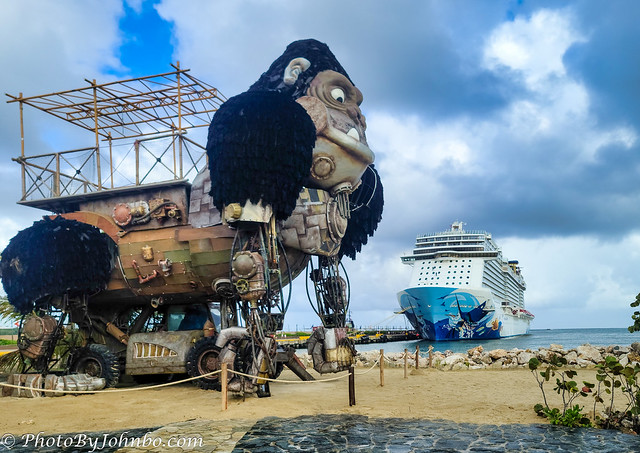

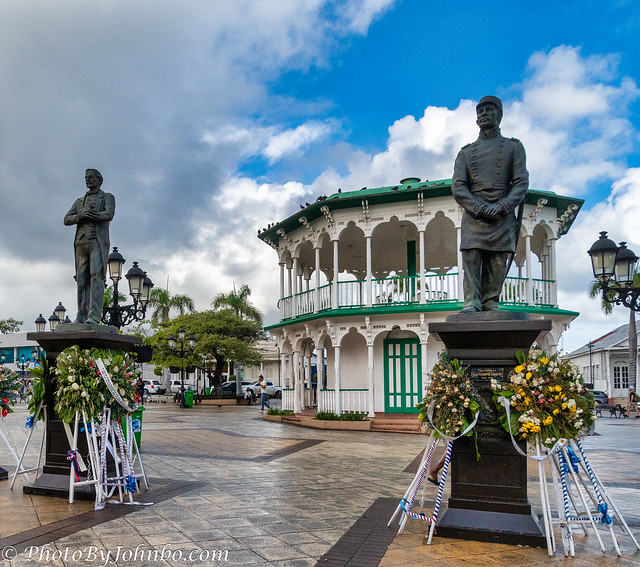


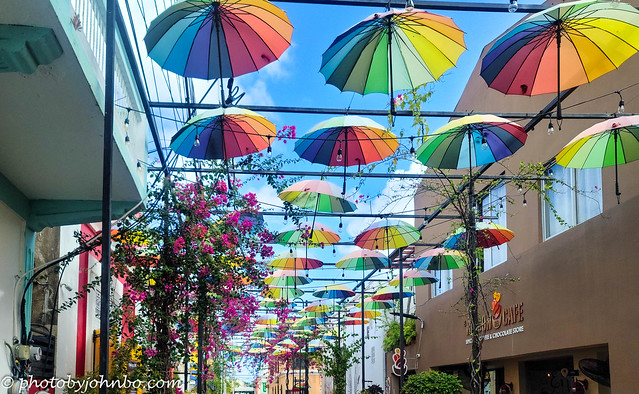

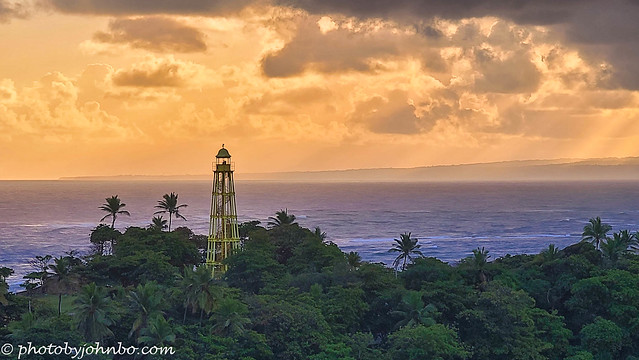
I always love lighthouses, here too.
My brother in-law wrote a travel guide to Dominican Republic in the 80’s when there wasn’t one available in Finnish ( this just as a side note )
Cool. I always thought writers of travel guides have the most interesting jobs.
The Dominican Republic is somewhere I’d love to visit, but this wander around with you is the next best thing.
Thanks, Margaret.
The street of umbrellas is certainly a wonder 🙂
It is, indeed! Our tour guide didn’t mention where we were walking until we were upon it. Nice surprise.
The umbrellas indeed look playful. They give such a carefree and happy feel!
They do, indeed!
More and more towns and cities seem to be creating those umbrella streets these days – something to attract the Instagramers I suspect 🙂 They do add a touch of colour! Your ship looks huge – how many passengers does it take?
The Norwegian Escape is one of the four largest ships in NCL’s fleet. It can support about 4,200 passengers with a crew complement of over 1700.
Wow, that’s massive! We’re looking at possible Arctic cruises for next summer and I’m concerned a 100 passenger ship is a bit big 😀
I understand. Big ships can seem crowded at peak times like sail-away and popular venues, but their size makes it relatively easy to find places where they don’t seem crowded at all.
A large ship also has the advantage of a more stable platform in rough seas. All in all, our worst rocky ride was on one of the smaller ships we cruised on in 1997.
Thanks for taking us on the tour with you John, The lighthouse is my favorite. It’s different and beautiful.
Thanks, Anne. Glad you enjoyed the tour.
😊
Nice to see that lighthouse again, John.
What a beautiful city! These are great photos. The Fortaleza San Felipe seems full of history.
It is, indeed. This tour was one of the better tours in covering so many interesting places.
I liked you amber photos, John. I love rocks! Also liked the multicolored umbrellas. So pretty.
You’d love that museum, Siobhan. There were plenty of examples of amber on display there.
Dominican Republic certainly has some good places to visit, particularly in maintaining the vestiges of the colonial period. I’m less convinced by the gorilla.
I don’t blame you about the gorilla. >grin<